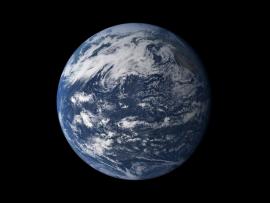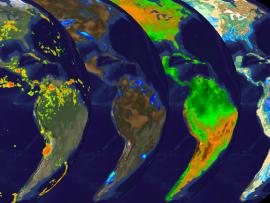Browse Hydrologic Cycle Resources
Browse Hydrologic Cycle Resources
Primary Topic:
Subtopics:
Type:
Standards:
Keywords:
Summary:
Water is a vital substance that sets the Earth apart from the rest of the planets in our solar system. In particular, water appears to be a necessary ingredient for the development and nourishment of life.
Primary Topic:
Subtopics:
Type:
Keywords:
Summary:
This unit will introduce you to many of the complex issues surrounding the Earth as a system and will help you to look at Earth in a new way—as a living system.
Primary Topic:
Subtopics:
Type:
Keywords:
Summary:
Explore how water moves across land and returns to the ocean in the final installment of the water cycle series. The visualizations illustrate the movement of water on land—from storage of precipitation in soil layers, to its transport via rivers.
Primary Topic:
Subtopics:
Type:
Keywords:
Summary:
Explore how water droplets form and fall from the sky in part three of the water cycle series. Watch how water vapor moves through the atmosphere and returns to Earth as rain and snow.
Primary Topic:
Subtopics:
Type:
Keywords:
Summary:
Explore water vapor in the air in part two of the water cycle series. This second part of our series on the water cycle illustrates the way in which evaporation and winds combine to move water from the ocean to the land.
Primary Topic:
Subtopics:
Type:
Standards:
Keywords:
Summary:
This flash animation takes viewers through four aspects of the water cycle: rain, water storage, vapor, and clouds.
Primary Topic:
Subtopics:
Type:
Keywords:
Summary:
The cryosphere consists of those parts of the Earth's surface where water is found in solid form, including areas of snow, sea ice, glaciers, permafrost, ice sheets, and icebergs. This animation shows fluctuations in the cryosphere.
Primary Topic:
Subtopics:
Type:
Keywords:
Summary:
Find out how scientists use the distinct sounds made underwater by different size raindrops to measure rainfall.
Primary Topic:
Subtopics:
Type:
Keywords:
Summary:
The S'COOL Project involves students (ages 5 - 20+) in real science, making and reporting ground truth observations of clouds to assist in the validation of NASA's CERES satellite instruments. Includes lesson plans and other related materials.
Primary Topic:
Subtopics:
Type:
Keywords:
Summary:
Learn about precipitation and how clouds are formed. Find out why scientists study clouds and how you can help NASA collect cloud observation data as part of the Students' Cloud Observation OnLine, or S'COOL, Project.










